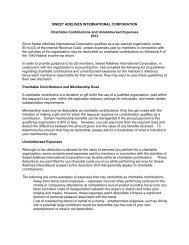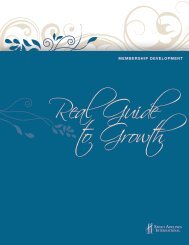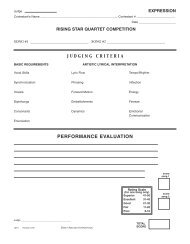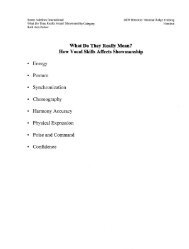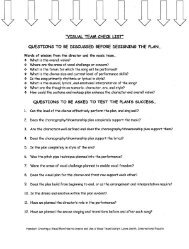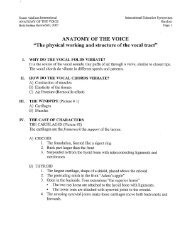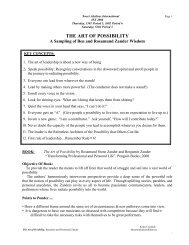Coordinator - Sweet Adelines International
Coordinator - Sweet Adelines International
Coordinator - Sweet Adelines International
You also want an ePaper? Increase the reach of your titles
YUMPU automatically turns print PDFs into web optimized ePapers that Google loves.
Chapter 1: Team Tools<br />
Regional Management Team Handbook<br />
4/13<br />
PLANNING FOR THE FUTURE<br />
“Would you tell me, please, which way I ought to walk from here?” asked Alice.<br />
“That depends a good deal on where you want to get to,” said the cat.<br />
“I don’t much care where,” said Alice.<br />
“Then it doesn’t much matter which way you walk,” said the cat.<br />
Strategic Planning<br />
Being a regional leader is a rewarding and challenging role, and in today’s world, it is<br />
complicated by the speed of change in modern life. The question is not whether a group<br />
will change, but how?<br />
The goal of the strategic planning process is to organize the future. A good plan can help<br />
close the gap between “what is” and “what is wanted.” Preparing a strategic plan is one of<br />
the most important processes any organization can undertake. Why? Focus, direction, and<br />
consistency are difficult to obtain—and even harder to preserve—in our environment of<br />
change and changing leadership. Strategic planning, if done well, provides for all three.<br />
Strategic plans are not intended to be “all things to all members.” They are designed to<br />
develop clarity of purpose and to determine how resources should be targeted and<br />
used for maximum results.<br />
Begin the planning process with an environmental analysis, an exercise that identifies<br />
the key external issues and/or trends that could impact the region in the future. When<br />
thinking about the future, it is important to study emerging trends as well as understand<br />
the current reality of how the region operates—its strengths and weaknesses. Another<br />
step in planning for the future is envisioning the end result. Skipping this step is like<br />
Alice in Wonderland hoping to find her way. The region will, absolutely, find its way,<br />
but, without a clear understanding of where it wants to go and a road map to help in<br />
getting there, who knows where it will be?<br />
The final element in effective strategic planning is the development of a clear<br />
implementation plan which links the written strategic plan with the current<br />
operational calendar. It is crucial to remember that a strategic plan is a living<br />
document that needs to be reviewed and updated on a regular basis so that it can be<br />
adapted to meet the group’s changing needs.<br />
Identify Guiding Principles<br />
Guiding principles are core values in action. Identifying and prioritizing core values is<br />
the first step in determining guiding principles. The following questions may help you<br />
and your team members focus on your values:<br />
• What are the qualities that make your <strong>Sweet</strong> <strong>Adelines</strong> life better?<br />
• What helps you survive, thrive, and prosper?<br />
• What would you like to have more of in your <strong>Sweet</strong> <strong>Adelines</strong> life?<br />
• What would you miss if it were eliminated from your <strong>Sweet</strong> <strong>Adelines</strong> life?<br />
• What qualities define the person you want to be?<br />
Team Tools • 1-27



